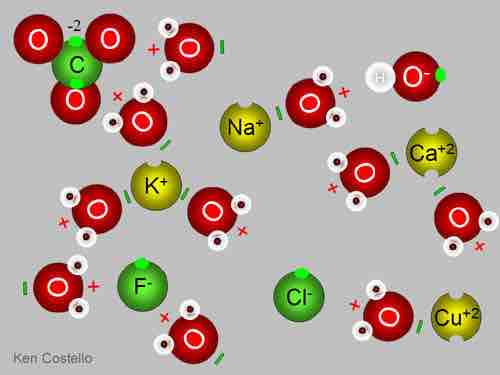The composition of tissue fluid depends upon the exchanges between the cells in the biological tissue and the blood. This means that fluid composition varies between body compartments.
Intracellular Fluid Composition
The cytosol or intracellular fluid consists mostly of water, dissolved ions , small molecules, and large water-soluble molecules (such as proteins). This mixture of small molecules is extraordinarily complex, as the variety of enzymes that are involved in cellular metabolism is immense. These enzymes are involved in the biochemical processes that sustain cells, and activate or deactivate toxins. Most of the cytosol is water, which makes up about 70% of the total volume of a typical cell. The pH of the intracellular fluid is 7.4. The cell membrane separates cytosol from extracellular fluid, but can pass through the membrane via specialized channels and pumps during passive and active transport.
The concentrations of the other ions in cytosol or intracellular fluid are quite different from those in extracellular fluid. The cytosol also contains much higher amounts of charged macromolecules, such as proteins and nucleic acids, than the outside of the cell. In contrast to extracellular fluid, cytosol has a high concentration of potassium ions and a low concentration of sodium ions. The reason for these specific sodium and potassium ion concentrations are Na+/K ATPase pumps, which facilitate the active transport of these ions. These pumps transport ions against their concentration gradients to maintain cytosol fluid composition of ions.
Extracellular Fluid Composition
The extracellular fluid is mainly cations and anions. The cations include: sodium (Na+ = 136-145 mEq/L), potassium (K+ = 3.5-5.5 mEq/L) and calcium (Ca2+ = 8.4-10.5 mEq/L). Anions include: chloride ( mEq/L) and hydrogen carbonate (HCO3- 22-26 mM). These ions are important for water transport throughout the body.
Plasma is mostly water (93% by volume) and contains dissolved proteins (major proteins are fibrinogens, globulins and albumins), glucose, clotting factors, mineral ions (Na+, Ca++, Mg++, HCO3- Cl- etc.), hormones and carbon dioxide (plasma being the main medium for excretory product transportation). These dissolved substances are involved in many varied physiological processes, such as gas exchange, immune system function, and drug distribution throughout the body.
Transcellular Fluid Composition
Due to the varying locations of transcellular fluid, the composition changes dramatically. Some of the electrolytes present in the transcellular fluid are sodium ions, chloride ions and bicarbonate ions. Cerebrospinal fluid is similar in composition to blood plasma, but lacks most proteins, such as albumins because they are too large to pass through the blood-brain barrier. Ocular fluid in the eyes contrasts cerebrospinal fluid by containing high concentrations of proteins, including antibodies.

Ions
Ions in solution